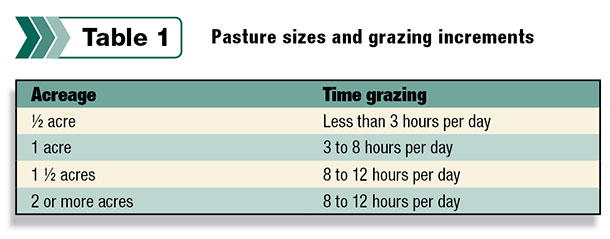Many horse owners utilize their pasture as an exercise area and rely on other sources to meet their horses’ nutritional needs. Since the nutritional needs are not the goal, you can run more horses on a piece of ground.
Exercise-area pastures should be monitored for noxious weeds, soil erosion and other hazards. Grasses are usually grazed to a shorter height.
Pastures that provide a large portion of the horse’s nutritional requirement need to be managed differently. Grass needs to be tall enough to allow the horse to graze comfortably.
The grass should also have enough height that it can continue photosynthesis to grow, and they need to have 70 percent cover of desirable plants.
The size of the pasture determines how many horses and how long they can graze to maintain a “good” pasture status.

Table 1 gives you some estimates of how much pasture you would need for one horse and how long it could graze each day.
Fit your schedule
Horses love to eat and need to consume 1.5 to 2 percent of their bodyweight on a daily basis. If allowed, they will graze almost 24 hours a day.
You can manage your horse pasture by managing your horse’s grazing behavior. One of the simplest things is to drylot your horse for part of the day or night.
There are many thoughts as to have them graze at night or during the day. My recommendation is to do what works for your schedule. By fitting the grazing time into your schedule, you are more likely to follow it through during the entire growing season.
Horses are selective grazers. This means they will re-graze the plants they really like and not graze others at all. The easiest way to manage this behavior is to make the grazing paddocks small; they do not have as much choice and are more likely to graze all the plants.
Dividing a large pasture into small pastures is an easy way to manage the grass. This can be done easily with portable/moveable electric fence. All you need is an electric fence charger, some tread-in or pound-in electric fence posts and a roll of electric fence.
The tread-in posts work well in most irrigated pastures. If your ground is too hard to tread the post into, you can use a cordless electric drill to drill a hole into the ground where you want to put your post first.
The other option is to use a disc from a field disc and weld a short upright on it your fiberglass post will fit into. You can place these anywhere.
As you determine how many paddocks you want in your pasture, you might want to consider having enough paddocks to ensure each has about a 10-day rest between repeated grazing.
Clean from weeds
Good pasture management includes surveying your pasture on a regular basis for weeds. If the pasture is maintained with a good canopy cover of desirable plants, then weeds are usually a minor issue.
Weeds are opportunistic and will invade overgrazed pastures and overgrazed areas. Weeds compete with desirable plants for space, nutrients, light and water.
The most effective weed control plan is prevention. This means maintaining the pasture with good canopy cover and preventing overgrazing. If you do have weeds, it is time to take control of them.
Step one is to determine what weeds you have. You can contact your local extension office or weed department for help in identification.
Once you know what weeds you have, step two is to determine why you now have a weedy area. Some reasons could be an overgrazing of an area, weed seed in some hay or wildlife bringing in the weed seed.
You can manage the weeds with various forms of control, but if you don’t address why you have noxious weeds, it is a losing battle.
Once you have identified the weeds, then you can determine what forms of control you would like to take. Some weeds can be controlled by pulling them. This works for weeds that have a tap root and are few in number. Be sure and bag the pulled weeds and take them out of the pasture.
Some weeds will go ahead and drop seed after they have been pulled. Some weeds can be controlled with regular mowing. This does not actually kill the weed, but it will keep them from going to seed and adding to the problem.
Depending on the weeds you have and the location of those weeds, there is a wide variety of herbicides available to landowners. Visit with someone who can guide you in recommending a herbicide that works for your weeds and your location.
Always read the label and follow all instructions regarding the rate of application, how close the product can be applied next to water and any grazing restriction.
Horse pastures should be managed by the goals the horse owner has for the pasture. There should be adequate forage to meet the horse’s nutritional requirements from the pasture or other source.
Always check the pasture for noxious weeds and practice weed prevention so you don’t have to practice weed control. By keeping all of this in mind, you should have a great-looking horse pasture. ![]()

Lemhi County Extension Educator







